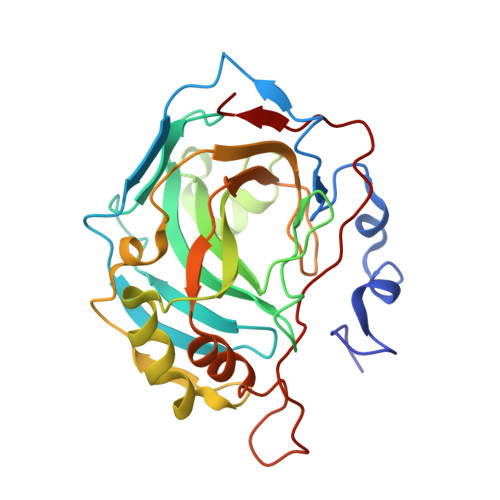Location of binding sites in small molecule rescue of human carbonic anhydrase II.
Bhatt, D., Fisher, S.Z., Tu, C., McKenna, R., Silverman, D.N.(2007) Biophys J 92: 562-570
- PubMed: 17071654
- DOI: https://doi.org/10.1529/biophysj.106.093203
- Primary Citation of Related Structures:
2FNK, 2FNM, 2FNN - PubMed Abstract:
Small molecule rescue of mutant forms of human carbonic anhydrase II (HCA II) occurs by participation of exogenous donors/acceptors in the proton transfer pathway between the zinc-bound water and solution. To examine more thoroughly the energetics of this activation, we have constructed a mutant, H64W HCA II, which we have shown is activated by 4-methylimidazole (4-MI) by a mechanism involving the binding of 4-MI to the side chain of Trp-64 approximately 8 A from the zinc. A series of experiments are consistent with the activation of H64W HCA II by the interaction of imidazole and pyridine derivatives as exogenous proton donors with the indole ring of Trp-64; these experiments include pH profiles and H/D solvent isotope effects consistent with proton transfer, observation of approximately fourfold greater activation with the mutant containing Trp-64 compared with Gly-64, and the observation by x-ray crystallography of the binding of 4-MI associated with the indole side chain of Trp-64 in W5A-H64W HCA II. Proton donors bound at the less flexible side chain of Trp-64 in W5A-H64W HCA II do not show activation, but such donors bound at the more flexible Trp-64 of H64W HCA II do show activation, supporting suggestions that conformational mobility of the binding site is associated with more efficient proton transfer. Evaluation using Marcus theory showed that the activation of H64W HCA II by these proton donors was reflected in the work functions w(r) and w(p) rather than in the intrinsic Marcus barrier itself, consistent with the role of solvent reorganization in catalysis.
Organizational Affiliation:
Department of Pharmacology and Therapeutics, College of Medicine, University of Florida, Gainesville, Florida, USA.
















